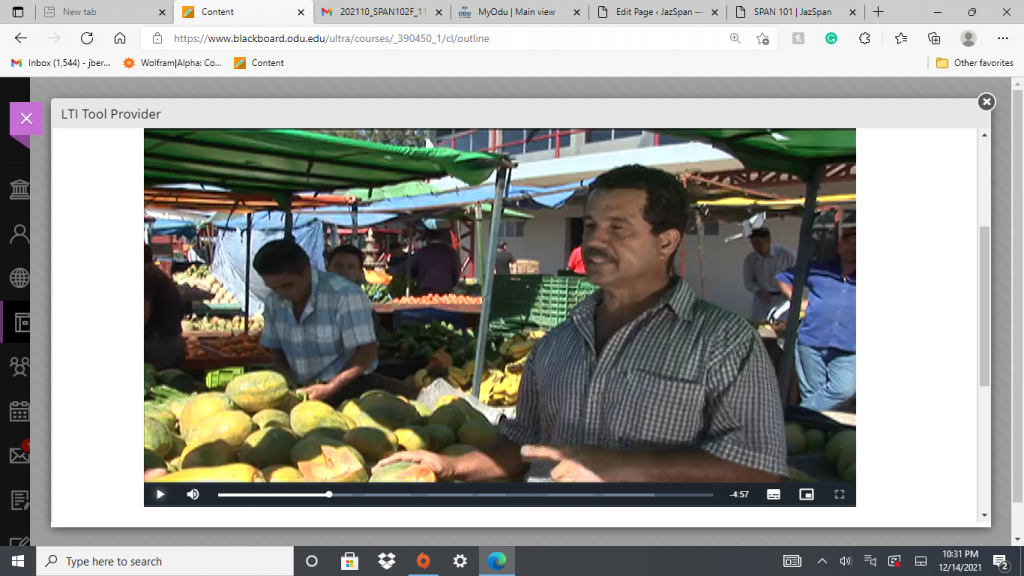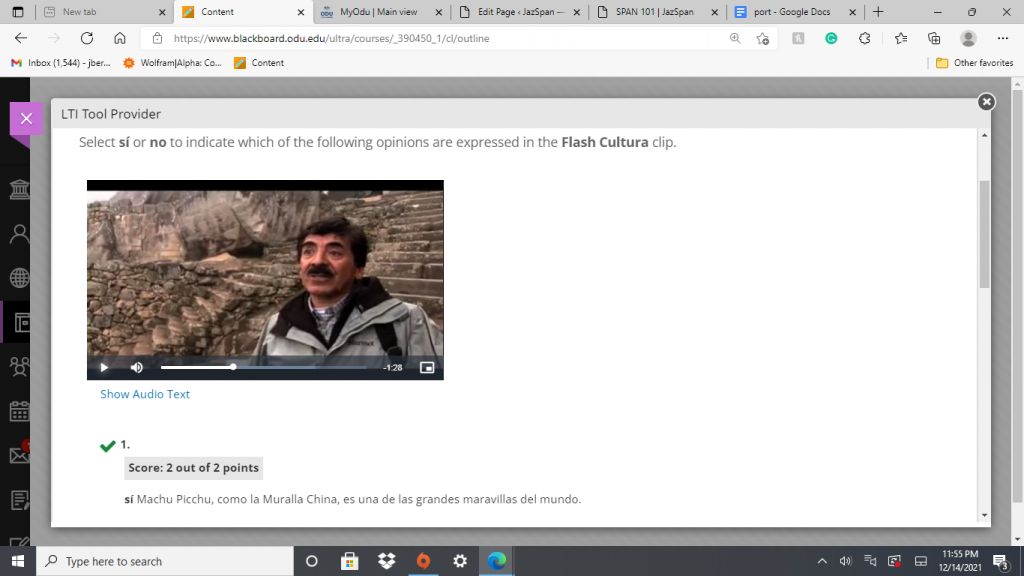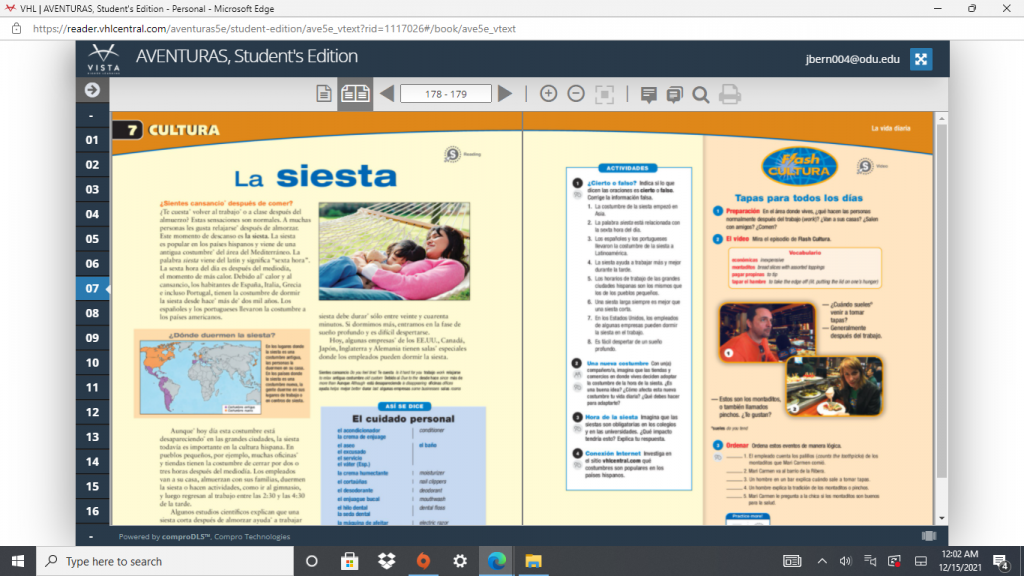Interpretive, Interpersonal, and Presentational Modes of Communication
Address the reflection exercises in each of the following sections. For each section, you will need to embed portions of these assignments and activities as artifacts to substantiate your reflection. Then, at the end of each section, include a link to the document or embed it as a PDF.
Tutorials are available:
- Embedding a PDF
- Embedding Media (Images, Audio)
- Embedding a Video
An Effective Reflection Is
- Written in English.
- A demonstration, explanation, comparison of skill and growth described through what you learned and the challenges you had in that learning while highlighting your best work.
- A discussion of how you overcame any weakness or obstacles. Explain what you mean.
- Supported by evidence as represented by your artifacts (course materials, photographs, video, conversations, projects, news reports, authentic materials, etc.).
- Specific, addressing particular strengths, weakness, skills, transformative experiences, etc., avoiding vague generalizations (ex: “I learned a lot.”).
An Effective Reflection is not
- Only sharing an artifact without context or discussion.
- Only a description or explanation of an artifact. Focus on your learning and growth as a result of having completed that experience.
- An attempt to justify your work to an instructor. Instead, think more broadly about future audiences that might benefit from seeing evidence of your work and the skills you are developing.
Artifacts
A good artifact is a portion or clip of an assignment. It needs to be carefully selected to provide evidence/proof that supports what you are saying in your reflection.
Your reflection will help you determine what that will be. It is a quest for quality. It will represent you academically and professionally, and have personal meaning. It can be written, audio, or video.
At the end, ask yourself if the artifacts best demonstrates your abilities and growth over time.
At the end of your reflection in each section, link or embed the assignment/artifact. If the assignment has multiple pages and seems to overwhelm the section, consider adding just the first page and offering to provide the rest upon request.
Instructions
Exploring Culture

In this class, we watched flash cultura videos that gave us information about the culture while also including related material from the chapter. In this video we got a sneak peek into a traditional supermarket, the types of foods you could find in them, and certain customs within the market. Afterward there was an assignment that asked questions about the information discussed in the video. We had one for every chapter that had something similar. This video allowed me to make comparisons between customs in other traditions, I found a lot of similarities between their culture and my culture(I’m half Jamaican) by how their markets are set up, the customs, and the mannerisms among each other. A few questions that could be used to analyze this video might be ” How is this similar to my culture” ,”How might their customs differ from other cultures?”, and “How do these customs shared in the video compare to what I’ve known before?”
Engaging in Communities
I believe that there are many benefits to engaging in immediate and global communities. First, it’s important to find value in your intermediate communities because you can develop personal connections with your culture and customs. You can also pick up on traditions and build a bridge between yourself and your community. Also, depending on where you’re from, there might be a lot of diversity within the community so you could slowly learn about others people’s cultures and be informed. It’s also important to learn about global communities to gain more knowledge about people and places you don’t know about. You can learn about new customs, foods, traditions, and meet new people in a respectful and cohesive way. It’s also beneficial to learn how to speak other languages so you can properly engage and communicate with other people of different cultural backgrounds and origins. Being in college has already allowed me to meet new people of many backgrounds including Indian, African, Hispanic, and Asian. I’ve gained a lot of knowledge from those experiences, and I gained even more knowledge within my classes that’s more tied into the Hispanic culture as a whole.
Interpersonal Communication
In this class, we had 2 TalkAbroad sessions that included the completion of a workbook assignment. We also had an in-person interview with our professor that required us to have a fluent conversation in Spanish. There were also other various activities within Vhl that required the repetition of Spanish words out loud.
Personally, I have mixed emotions about TalkAbroad.I liked that I was able to speak to someone who’s a native Spanish speaker and engage in conversation with them, but my preparation lacked in some areas and I had a hard time fighting nervousness. For other people, though, I can see how it’s an eye-opening experience. The interview with our professor was easier because the professor had more guidance throughout the interview in case you got stuck trying to say something. The most difficult part for me was not letting my nerves make me forget important information. Since the first activity, I progressed greatly and was able to form more coherent and longer sentences. If I had another chance I would have spent more time preparing for the conversations and going over more material. Aside from those issues, I really enjoyed learning about how my TalkAbroad partners.
Presentational Speaking
We didn’t have any presentation projects this semester but I would consider the interview with my teacher to be a form of presentational speaking as well. It wasn’t specifically a presentation to the class or a project, but I did have to show my fluency in speaking Spanish and my ability to understand what was said to me.
Presentational Writing
Throughout our course, we did two compositions. The compositions required us to write a few paragraphs that followed a certain prompt about the Chapter. The first one was about an interview with a random student about fashion at ODU. The second one was about describing a restaurant.
These compositions weren’t very hard but required you to know the material. I did better on my second composition because I prepared thoroughly, but the first composition would have had similar difficulty if I prepared. I overcame writing blocks by preparing a proper outline beforehand and memorizing certain vocabulary that can be used in multiple questions/answers. The picture below is a written copy of my second composition.
Interpretive Listening

We had multiple videos where we had to watch and listen to the information in a video and answer questions. Some required yes or no answers or multiple choice.
This specific activity required yes or no answers. I found it a bit more difficult than multiple choice because the questions had all or partial information, which meant that if you did not remember what was specifically said, you’d need to go back multiple times to double-check. Going back and forth within the videos is definitely the most annoying part of the video activities, but overall they are not very difficult.
Interpretive Reading

In the Vhl online textbook, there are a few different activities that require you to read a little article and answer questions based on information within the article. Some of them are specific and only cover one topic ( such as a flyer for a vacation or prices for clothes), whereas this one has many subjects within in.
If your comprehension is good then the activities are decent and interactive, but I find the format overwhelming since my comprehension isn’t the best. I usually pick out words and phrases I know or find information based on the questions, but I had a hard time understanding certain chunks of information within this article. Throughout the semester the assignments got progressively easier but there were always moment where I couldn’t understand everything that was shown.
When you have finished adding content to this page, delete all the instructions except the link to the Modes of Communication.